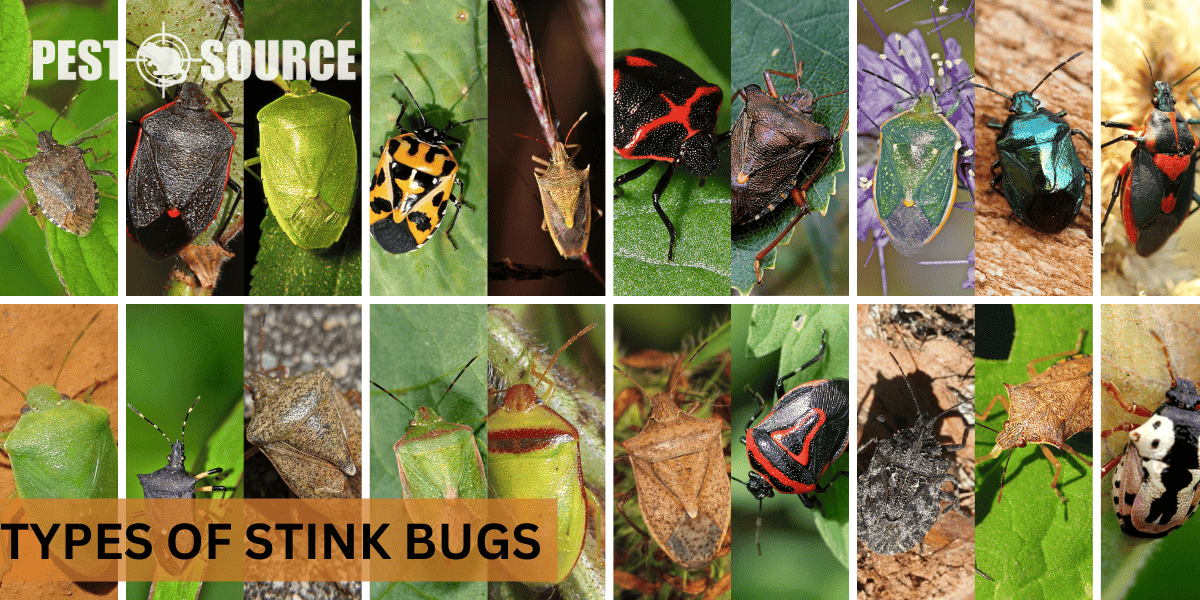Welcome to the diverse world of stink bugs, a group of insects that are as fascinating as they are varied. These shield-shaped bugs, while often regarded as mere garden nuisances, play complex roles in our environment. Some are harmful devourers of vast plant species, while others are beneficial predators keeping various pests in check.
Whether you’re a homeowner tired of the yearly invasion or a farmer grappling with crop damage, understanding the differences among these bugs is the first key in dealing with them effectively. In this comprehensive guide, we will delve deep into the world of stink bugs, exploring their types, identifying look-alikes, and offering practical advice to control and prevent them.
POINTS
- Stink bugs, part of the Pentatomidae family, are shield-shaped insects with distinct colors and sizes, but most importantly, they’re famously known for their defensive foul smell. Some species can pose a significant threat to crops and plants.
- There is an incredibly diverse variety of stink bugs. With over 200 species in North America alone, they share common traits such as a shield-like shape and range from brown to green in color.
- Some stink bugs are seen as pests, severely damaging crops, and invading homes. Others are beneficial, controlling other harmful insect populations and proving beneficial to agriculture.
- There are many bugs that are often mistaken for stink bugs, due to their similar shield-like shape or size. These include certain look-alike beetles and some varieties of shield bugs.
- The successful prevention and control of stink bugs necessitate an understanding of these bugs and the implementation of effective practices such as sealing cracks to keep them out, installing bug lights, regular cleaning, etc. If in doubt, always seek the help of pest control professionals.
What Are Stink Bugs and Why Should We Be Concerned About Them?
What are stink bugs?
Stink bugs are part of the Pentatomidae family, which are shield-shaped insects notorious for their unwelcome “stinky” defense mechanism. This unpleasant smell is released from glands located on the underside of their body and is used as a deterrent against predators. They come in a variety of species, boasting different sizes and colors.
What do stink bugs look like?
Stink bugs are known for their distinctive shield-like shape. While their color could vary between species, they mostly have bodies that range from brown to green. Some species are more vibrant, exhibiting different shades of red, orange, yellow, or sometimes even having blue and black body with white markings.
Do stink bugs bite?
No, stink bugs do not bite humans. They are usually harmless and prefer to keep to themselves. However, when feeling threatened, they will release a pungent odor that could be slightly irritating, especially if you have a sensitivity or allergy.
Why is there a concern about stink bugs in agriculture and domestic settings?
While these bugs may seem harmless to us, stink bugs pose a significant threat to both agricultural and domestic settings. Some species are known to feed aggressively on a wide variety of plant species, leading to stunted growth or even the death of the plant.
Furthermore, stink bugs have a tendency to invade homes during colder seasons, making them a nuisance to homeowners. This dual threat to both our gardens and homes makes the effective identification, control, and prevention of these pests a matter of paramount importance.
Understanding the Diversity of Stink Bugs
How many types of stink bugs are there?
The diversity of stink bugs is vast, with over 200 species existing in North America alone and approximately 5,000 worldwide. Each species has its unique characteristics, and while some are incredibly destructive, others are beneficial to our environment and agriculture.
What are the common characteristics of stink bugs across species?
Despite their diversity, all stink bug species share a few common traits. For instance, they all possess a shield-like shape and typically range from brown to green in color. Their primary defense mechanism is to emit an unpleasant smell when threatened, acting as a deterrent against potential predators.
Comprehensive Guide to Common Types of Stink Bugs
From different colors to varying sizes, stink bugs can be quite diverse. Here’s a comprehensive guide to some of the most common types of stink bugs.
Pest Stink Bugs
1. Brown Marmorated Stink Bug (Halyomorpha halys)
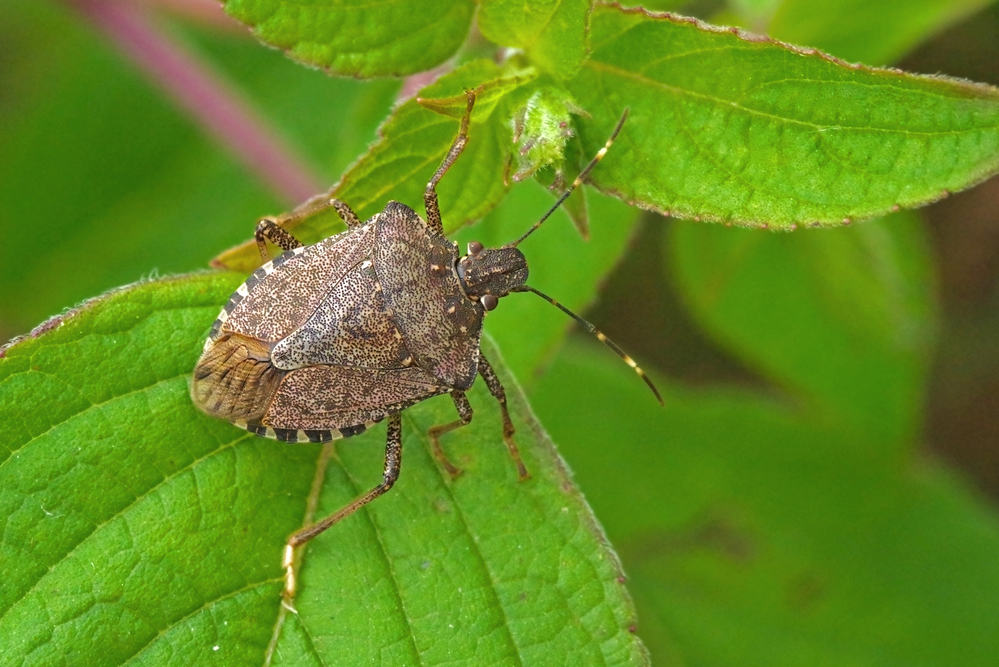
This species has a marbled or “marmorated” grey-brown color, which led to its naming. They are shaped like shields and sized about 1.6 cm (2/3 inch) long and 1 cm (2/5 inch) wide. They are native to East Asia but have effectively invaded the United States and Europe because of their ability to resist cold winters. They produce an unpleasant odor when threatened or killed as a defense mechanism. They are known as significant pests in agriculture, infesting a wide range of fruit, vegetable, and other crops.
2. Green Stink Bug (Chinavia hilaris)
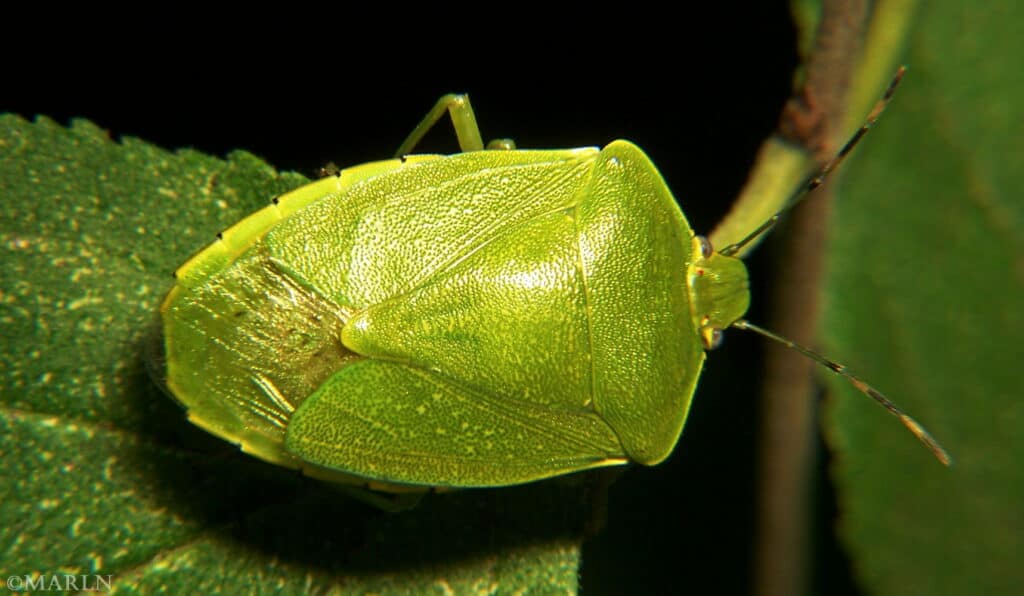
Also known as the Green Soldier Bug, this stink bug is bright green in color, with narrow yellow, orange, or reddish edges. It is usually between 13 to 18 mm in length. They are primarily found in the eastern and southwestern regions of the United States. They are known to feed on over 100 types of plants, including many common crops, making them a significant pest.
3. Black Stink Bug (Proxys punctulatus)
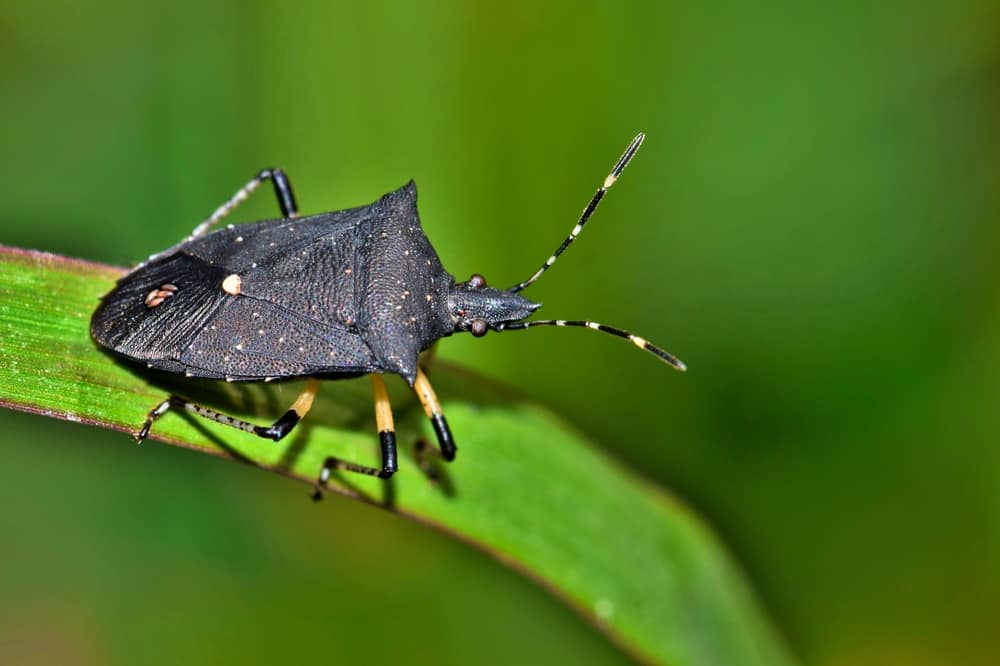
This species is characterized by its black or dark color with white spots on its wings and abdomen. They are smaller in size, usually about half an inch long, and are known to be destructive pests to a variety of crops including beans, peas, and tomatoes among others, as they suck the plant juices causing discoloration and deformation.
4. Southern Green Stink Bug (Nezara viridula)
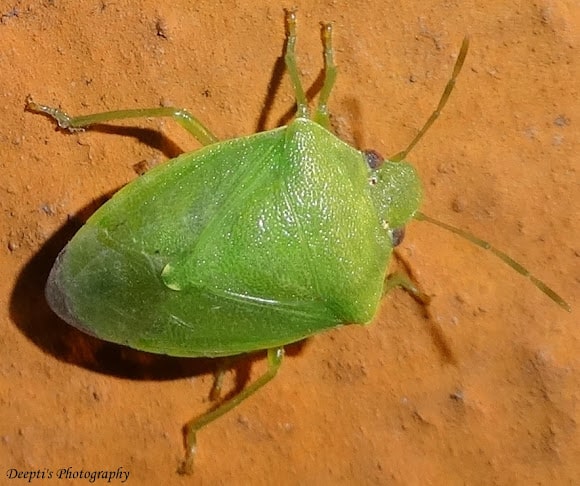
This species is bright green and shield-shaped, resembling a Green Stink Bug, but slightly larger with a length of 12-19 mm. It is a cosmopolitan species, which means it can be found all over the world. It is known as a severe pest because of its wide host range of over 30 families of plants, including many economically valuable crops such as beans, peas, tomatoes, and cotton. In their adult life, they can range from green to straw-colored depending on their age and environmental conditions.
5. Brown Stink Bug (Euschistus servus)
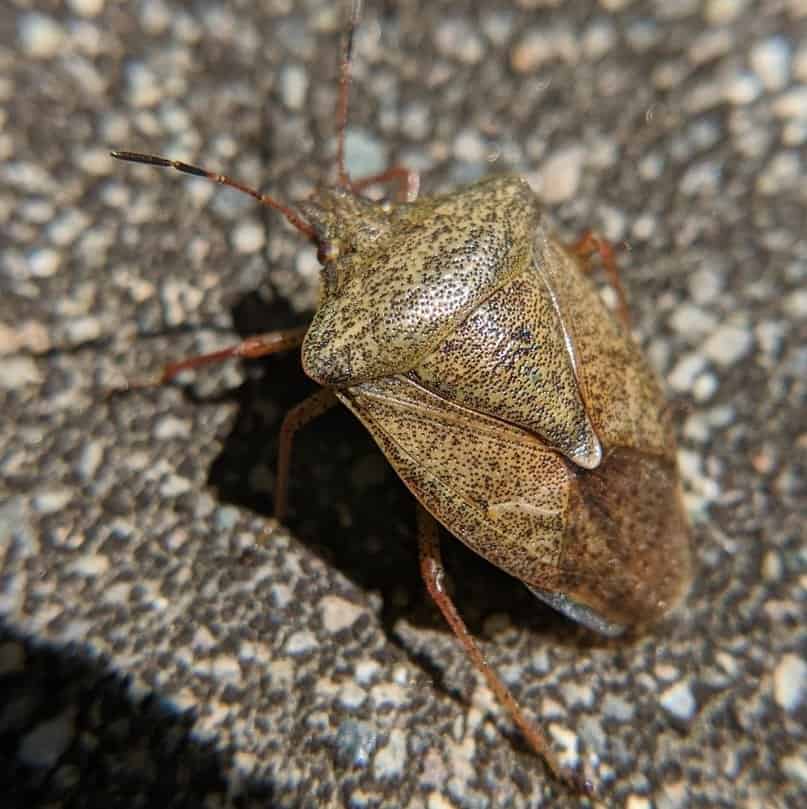
As suggested by the name, this species is brown in color and characterized by its pronounced, forward-pointing “shoulders” and a smooth, shield-shape. The adult size is around 1/2 inch long. Mainly found in North America, these bugs are known for feeding on a wide variety of plants, including soybeans, corn, and cotton, and are thus considered significant pests in agriculture.
6. Conchuela Stink Bug (Chlorochroa ligata)
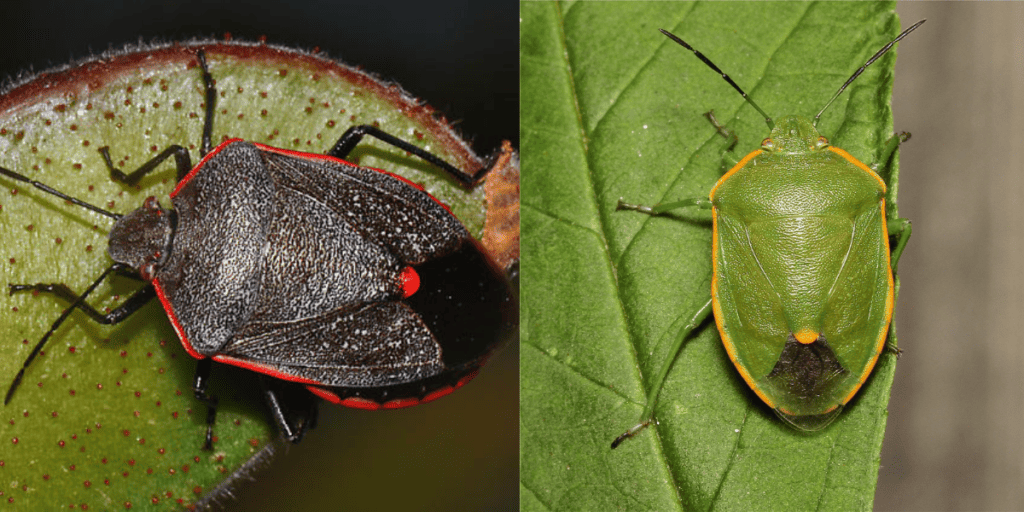
This stink bug is distinguished by its dark green to black color, with a distinct narrow, light-colored band around the edge of its body. Roughly 1/2 inch long, Conchuela stink bugs are largely found in Southwestern United States and Mexico and are known to feed on the seeds and fruits of both cultivated and wild plants.
7. Harlequin Bug (Murgantia histrionica)
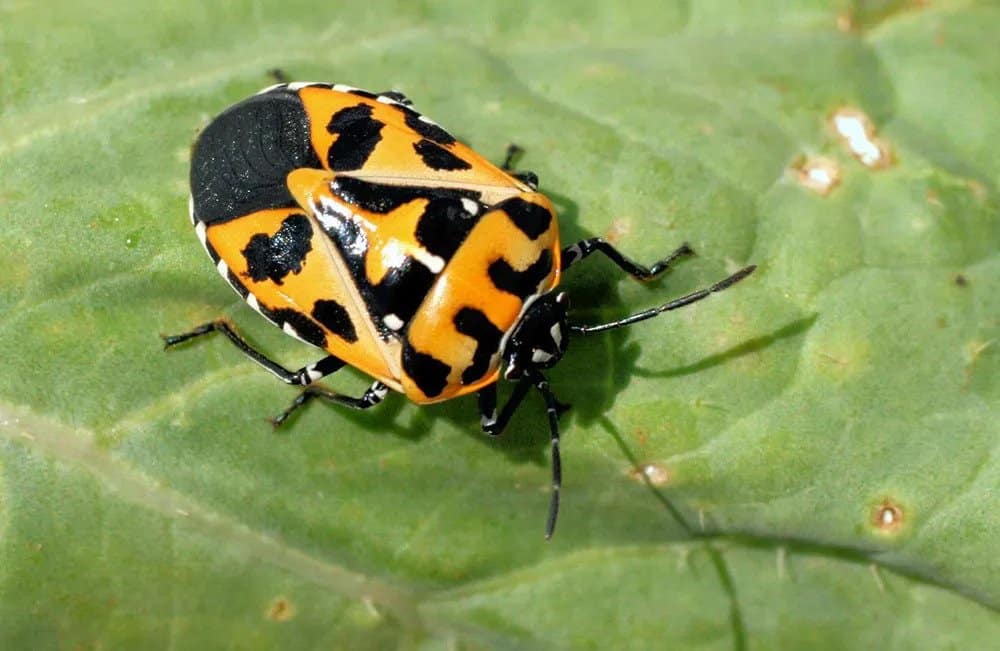
Displaying a striking black color with brilliant red, orange, or yellow markings, these bugs are a type of stink bug well known for their uniquely vibrant and colorful patterns. They grow up to 11 mm in length and can be found across the United States and Mexico. Unfortunately, they are notorious for being destructive pests to crops like cabbage and broccoli.
8. Red-shouldered Stink Bug (Thyanta custator)
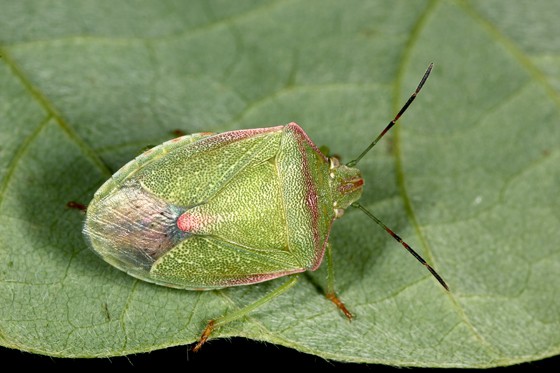
These stink bugs are naturally green or brown, but can turn red during winter months, hence the name. They are around 1/2 inch in length and primarily found across North America. Red-shouldered Stink Bugs feed on a variety of plant species, and while they can do significant damage, they are less harmful compared to other stink bug species.
9. Redbanded Stink Bug (Piezodorus guildinii)
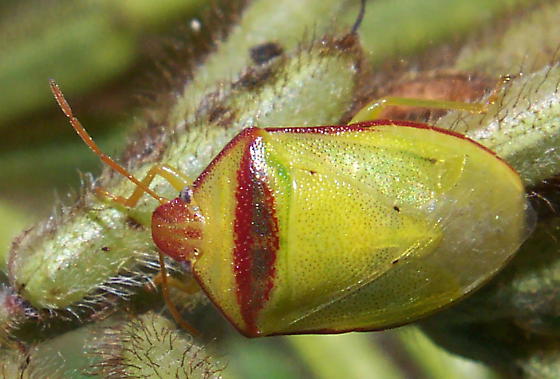
This is a smaller species, growing up to a length of 10-11.5 mm. As the name suggests, this stink bug has characteristic red bands across its green or gray body. It is primarily found in North and South America and is a significant pest to soybean crops.
10. Rice Stink Bug (Oebalus pugnax)
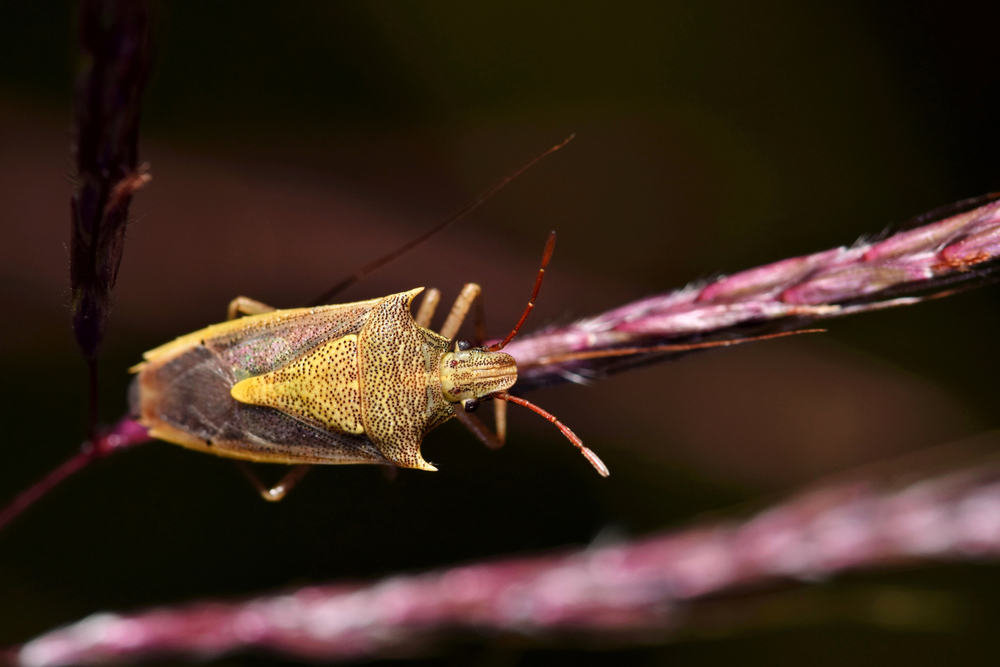
This is a major pest in rice crop fields, hence its name. It is about 12-14 mm long; and has a slender, long body compared to the more shield-shaped species. Its color is a mix of yellow, brown, and green. Its typical range includes the Southern United States and Central America.
11. Twice-stabbed Stink Bug (Cosmopepla lintneriana)

Appropriately named for the two red or orange marks on its otherwise black body, giving it the appearance of being “stabbed” twice. They are relatively small, reaching only up to 7 mm in length. Typically found in North America, these stink bugs are best known for their striking color contrast. They don’t pose a significant threat to crops, but they may occasionally feed on fruit trees and ornamental plants.
12. Forest Bug or Red-Legged Shield Bug (Pentatoma rufipes)
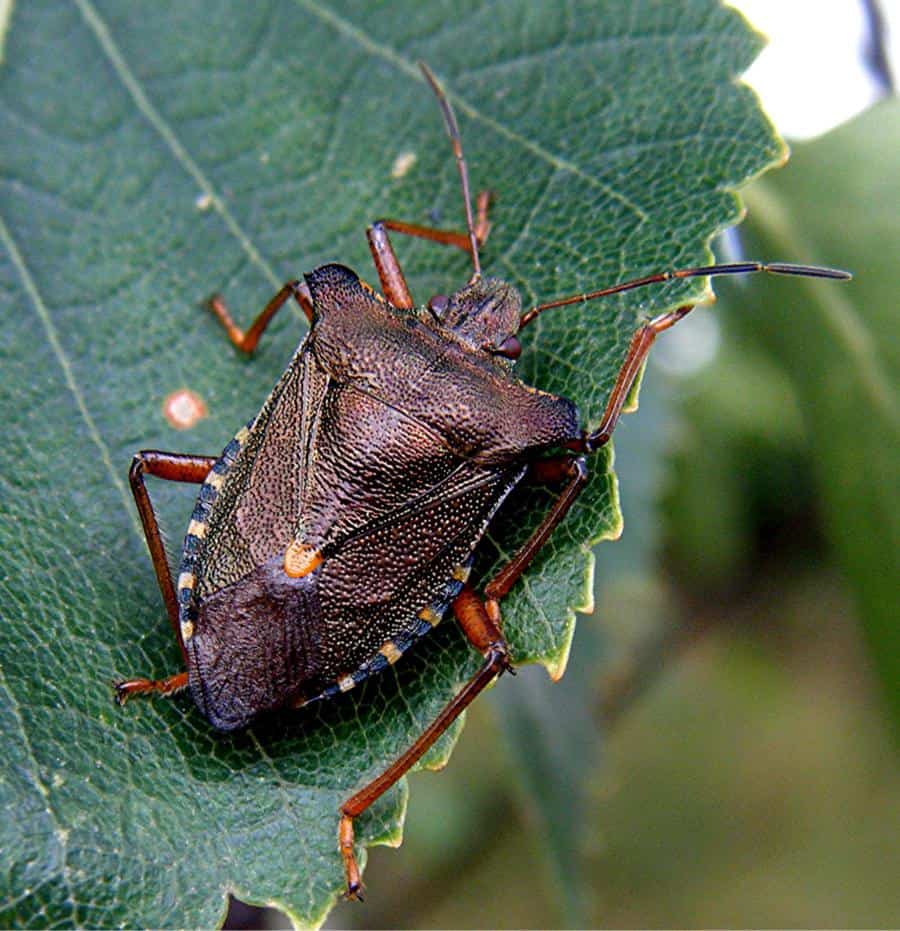
This bug has a dark brown or black body, with the edges of the abdomen and legs being a bright red or orange. These insects are commonly found in forests and wooded areas throughout Europe and Asia. They can grow up to 14mm in length and are known to feed on various fruits, leaves, and insects.
13. One-spotted Stink Bug (Euschistus variolarius)
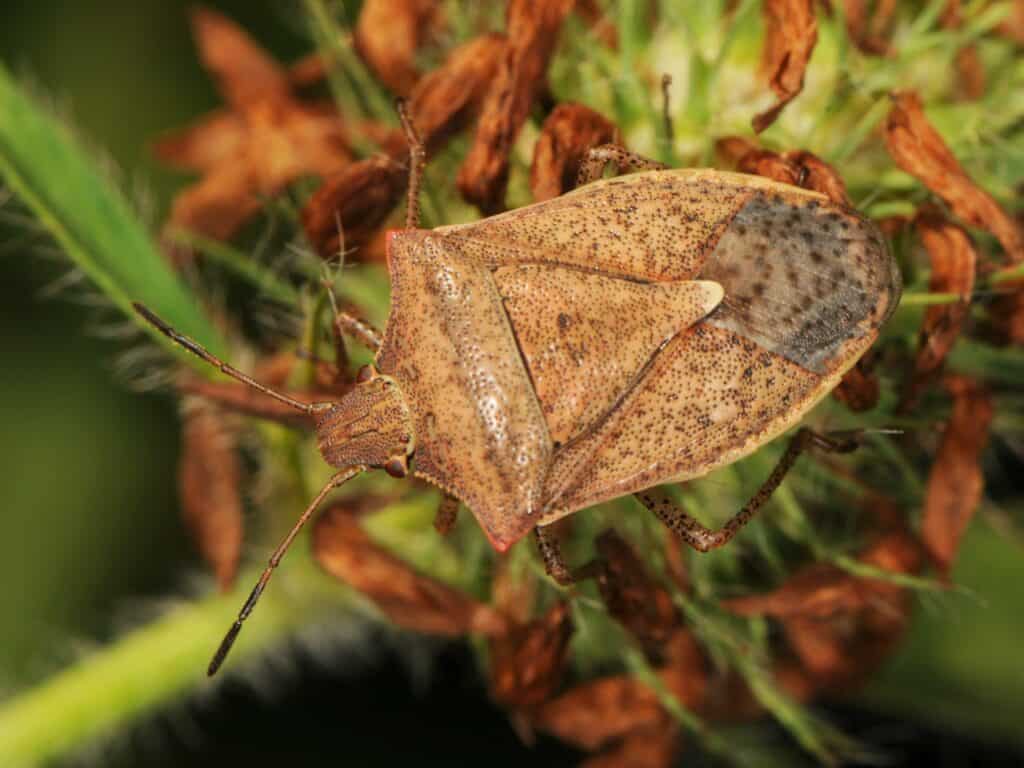
This stink bug species is typically brown or gray in color, with a prominent dark spot on the middle of its back. It is native to North America and can grow up to 12mm in length. These bugs are considered to be a minor agricultural pest, feeding on a variety of crops but usually not causing significant damage.
14. Say Stink Bug (Chlorochroa sayi)
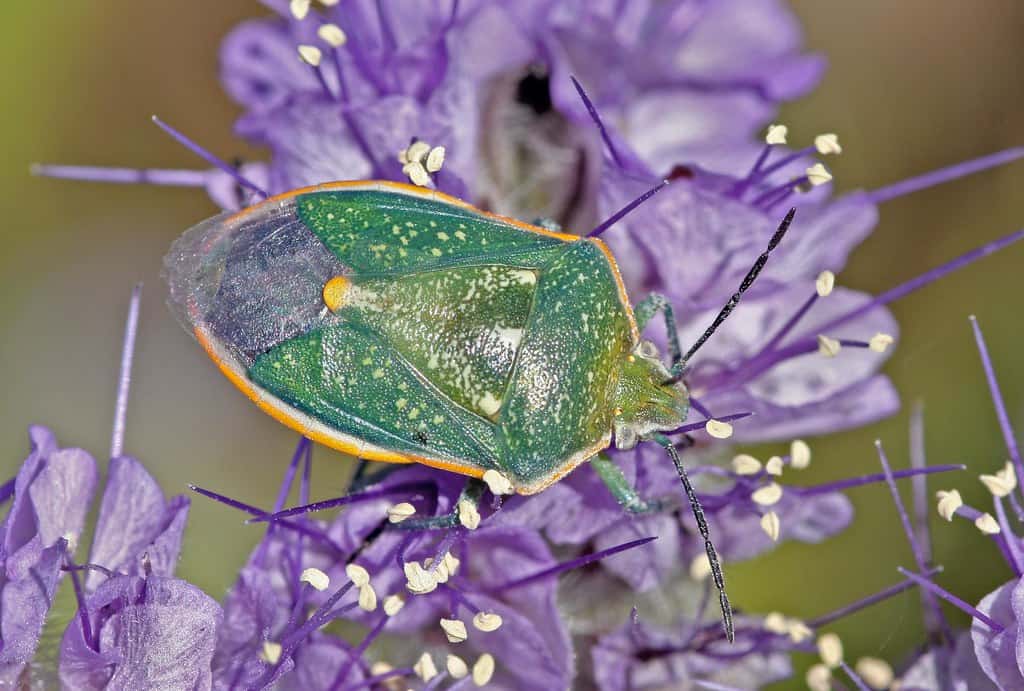
Named after Thomas Say, an American naturalist, this stink bug possesses a green body and can grow up to 13mm in length. Mostly found in Western North America, they feed on plant juices from a variety of crops and are considered minor pests.
Beneficial Stink Bugs
While many stink bugs are destructive, some help control other harmful insect populations, proving beneficial to gardens and fields.
15. Blue Shield Bug (Zicrona caerulea)

This type of stink bug is known for its vibrant blue or blue-black color. They measure around 5-7 mm in length. Their antennas and legs may have red or orange hues. It is a predatory species that feeds primarily on weevil larvae, caterpillars and other soft-bodied insects. Its habitat essentially covers the temperate regions of Asia and Europe.
16. Florida Predatory Stink Bug (Euthyrhynchus floridanus)
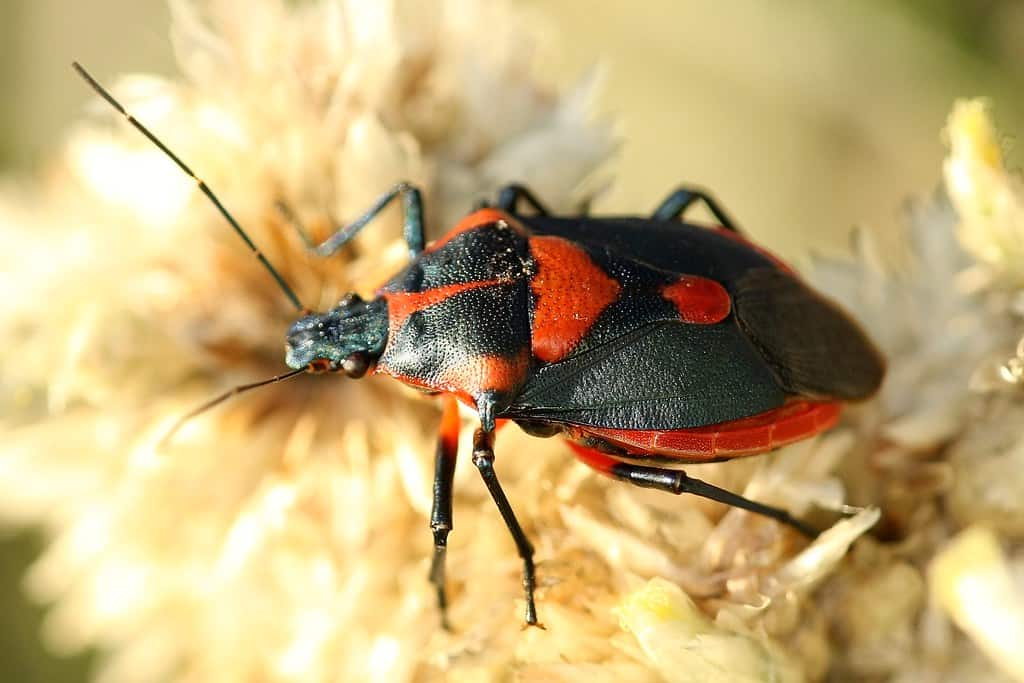
Also known as the Halloween bug because of its black and orange coloration, this species can reach lengths up to 19 mm. It is native to North America, especially in Florida. Unlike most stink bugs, it is a beneficial insect as it preys on various harmful pests from caterpillars to beetles.
17. Anchor Stink Bug (Stiretrus anchorage)

Distinguished by the unique anchor-like mark on its back, this bug is orange and black in color. It can grow up to 10mm and is primarily found in North America. Unlike many stink bugs, the Anchor Stink Bug is a predator, feeding on various pests which makes it beneficial for controlling harmful insect populations in gardens and farms.
18. Spined Soldier Bug (Podisus maculiventris)
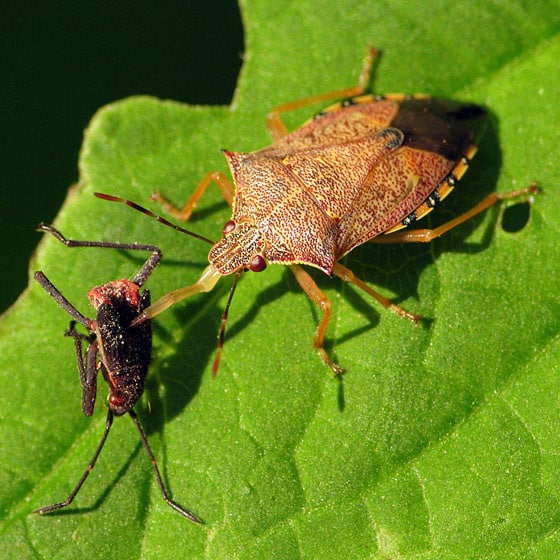
Recognizable by their pointed “shoulders” and spiny appearance, these bugs range in color from brown to tan, with varying marking patterns. They are beneficial insects, preying on nearly 100 species of harmful pests and caterpillars. They are native to North America and are approximately 1/2 inch long.
19. Rough Stink Bug (Brochymena spp)
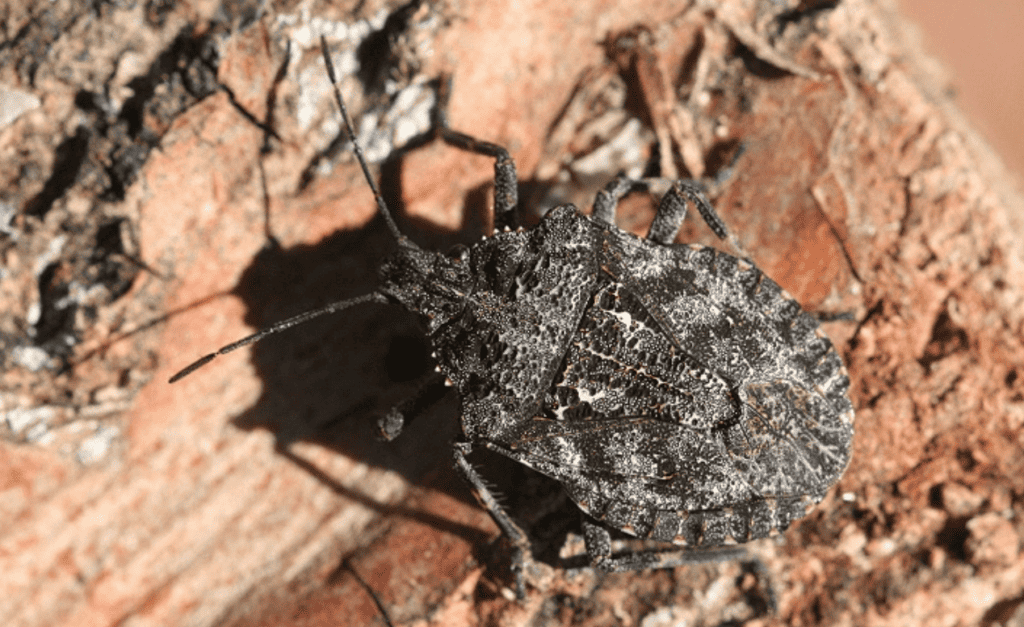
This species is known for its bumpy, rough texture and camouflaged coloration that resembles tree bark, aiding it in blending into its surroundings. They are generally harmless to crops and plants and are found across the United States.
20. Two-spotted Stink Bug (Perillus bioculatus)
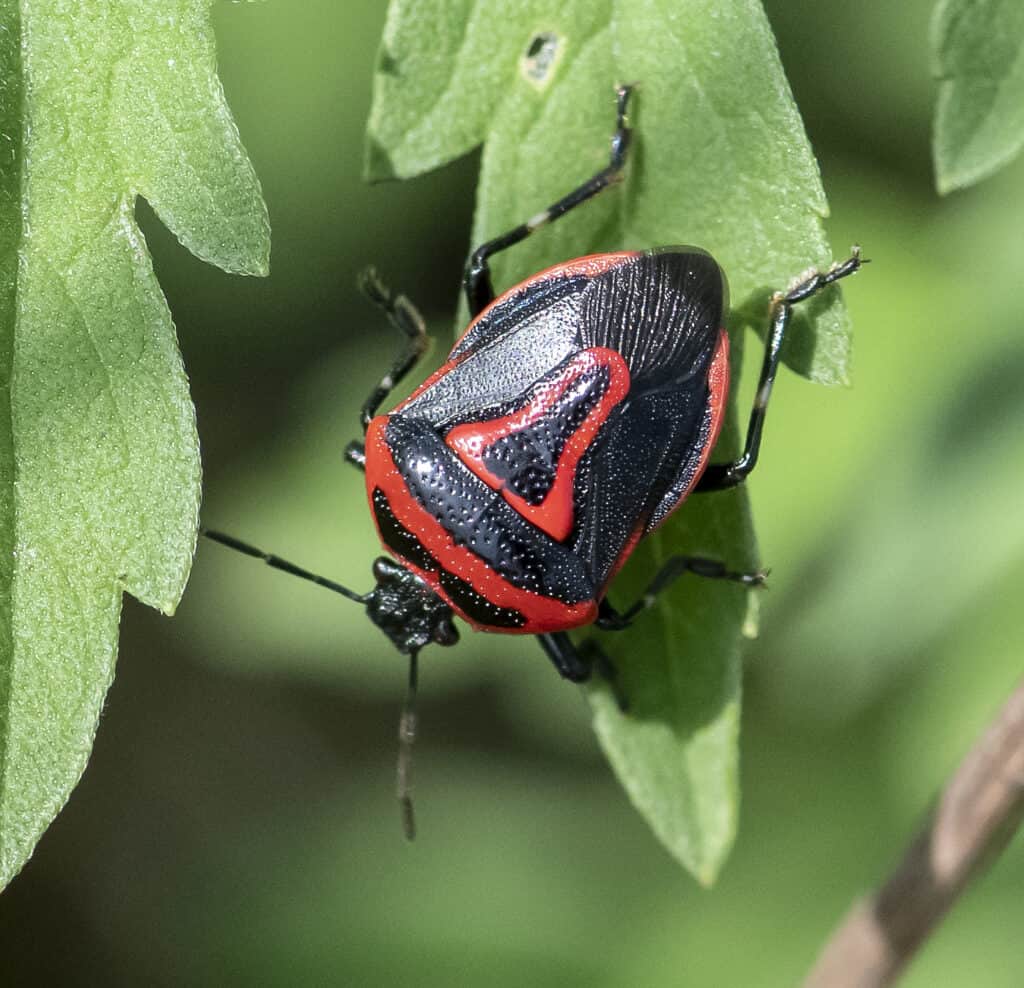
This bright red and black stink bug is known for its beneficial predatory behavior, feeding on harmful insects like the Colorado Potato Beetle. They range in size from 8 to 12 mm. A native of North America, these bugs are noted for having two black spots on their red pronotum, inspired by their name.
Common Stink Bug Confusions and Look-Alikes
Besides the abundance of different stink bug species, there are also numerous bugs that look remarkably similar to stink bugs. Let’s find out more about these look-alikes and how to tell them apart.
What are the bugs that look like stink bugs?
Given the diverse range of stink bugs, it’s not surprising that other bugs end up looking incredibly similar to them. This includes certain types of beetles, some varieties of shield bugs, and squash bugs. While these insects may seem identical at first, a keen eye for certain differing characteristics can help tell them apart.
What are the bugs that are similar to stink bugs?
Bugs similar to stink bugs include beetles and shield bugs. They might share the bug’s shield-shaped body or even their size, but these bugs lack the distinct, potent odor stink bugs release when threatened.
Are there bugs that look like stink bugs that bite?
While stink bugs don’t bite, their look-alikes such as the assassin bug and kissing bugs do, and they can be harmful to humans.
What bug looks like a giant stink bug?
The Giant Strong-Nosed Stink Bug or ‘Alcaeorrhynchus grandis’ looks a lot like a stink bug, but much bigger, it can grow up to 19 mm in length. They are predatory and beneficial for pest control.
Is there a big bug that looks like a stink bug?
The Leaf-Footed Bug resembles a large stink bug. They have a similar body shape, but leaf-footed bugs are distinguished by the leaf-like expansions on their hind legs.
Are there dangerous bugs that look like stink bugs?
Yes, the kissing bug, which can transmit the Chagas disease, shares similarities with stink bugs. Its oval shape and size can often lead to confusion, but kissing bugs are usually darker and have characteristic orange or red markings around the edge of their bodies.
Is there a bug that looks like a shield?
Yes, there is a bug that looks like a shield, and that is in fact the stink bug. Stink bugs are often referred to as shield bugs due to their distinct shield-like shape. Their bodies are broad and somewhat triangular, reminiscent of a medieval shield, which is the primary reason they are called shield bugs. This shape is common across all species of stink bugs and is a tell-tale sign when trying to identify them.
But don’t get confused, even though stink bugs and shield bugs are used as interchangeable terms in some regions, like North America, they are scientifically the same insect belonging to the family Pentatomidae.
Now, where they differentiate is the stench. Notably, most stink bugs are capable of releasing a foul odor as a defense mechanism against potential threats or predators, which gives them their ‘stink’ bug moniker. On the other hand, while most shield bugs share the same morphology, not all have this stinky reputation, making ‘stink bug’ a more specific term within the broader category of ‘shield bugs.’
Stink bug vs. shield bug: What’s the difference and how to identify each?
While the term ‘stink bug’ is often used interchangeably with ‘shield bug’, particularly in North America, the main difference lies in their odor. Stink bugs are known for their pungent smell when threatened, whereas most shield bugs do not share this foul-smelling defense mechanism.
What are the diamond-shaped bugs and are they related to stink bugs?
Diamond-shaped bugs are typically types of beetles and are not directly related to stink bugs though they can have superficial resemblances in appearance. Seat bugs, for example, are known for their diamond-shaped bodies but lack the distinct pungent defense mechanism found in stink bugs.
Unique Stink Bug Characteristics: Color and Shape Varieties
”Stink bugs” encompasses a wildly diverse group of insects, each with its unique set of characteristics. Here, we delve deeper into the diverse world of stink bugs to decipher them better.
What are the colors of stink bugs?
Stink bugs come in a variety of colors ranging from shades of brown, green, red, and blues to more unique hues of orange, yellow, and even black. The color will largely depend on the species, and some can even change their color based on the season or their age.
What is the significance of the colors in stink bugs?
The colors in stink bugs can serve several functions. For some, different shades can provide camouflage, allowing them to blend in with their surroundings. For others, bright colors might be a warning to predators that the bug is not tasty, or even dangerous.
What are those little black bugs that smell when squished?
In all likelihood, the little black bugs that smell when squished are a type of stink bug known as the Black Stink Bug (Proxys punctulatus), identifiable by their dark color and distinctive odor when threatened.
Is there a small black stink bug?
Yes, the Black Stink Bug (Proxys punctulatus) is on the smaller side for stink bugs, usually about half an inch long. They’re characterized by a black or dark color, often with white spots on their wings and abdomen.
Is there a diamond-shaped bug?
Yes, there are diamond-shaped bugs; however, they are typically types of beetles rather than stink bugs. The diamond shape comes from their elongated, pointed bodies.
What bug have a flat back?
A variety of bugs can have a flat back, including the shield bugs and stink bugs, which have a broad and somewhat flat body shape.
What bug has a triangle on back?
The triangular marking is quite common among stink bug species. For instance, the Brown Marmorated Stink Bug (Halyomorpha halys) has a solid, triangular back when viewed from above.
Is there a blue stink bug?
Yes, the Blue Shield Bug (Zicrona caerulea) is a type of stink bug known for its vibrant blue or blue-black color. It is a beneficial predatory species that feeds primarily on weevil larvae, caterpillars, and other soft-bodied insects.
Is there a grey stink bug?
Yes, the Brown Marmorated Stink Bug (Halyomorpha halys), despite its name, can sometimes appear grey due to the mottled pattern on its back.
Is there a red and black stink bug?
Yes, one of the most striking examples of a red and black stink bug is the Harlequin Bug (Murgantia histrionica), known for its bright red, orange, or yellow markings on a black background.
Is there a black and orange stink bug?
Yes, black and orange stink bugs do exist. One notable example is the Florida Predatory Stink Bug (Euthyrhynchus floridanus), also known as the Halloween bug due to its black and orange coloration.
Is there a black and white stink bug?
Yes, the Black Stink Bug (Proxys punctulatus) is characterized by its black or dark color with white spots on its wings and abdomen, giving it a black and white appearance.
Tips for Stink Bugs Prevention and Control
Stink bugs can prove to be a nuisance in your garden and your home. Here are some useful tips to help control and prevent an infestation.
How can homeowners and farmers differentiate between beneficial and pest stink bugs?
Differentiating between the beneficial stink bugs and destructive ones can seem challenging due to their similar appearances. However, knowing the habitats and behaviors of different species can help in identifying them. Pest stink bugs are often found on crops and plants they damage, showing visible signs of destruction. In contrast, beneficial stink bugs are usually seen preying on other insects.
If you’re unsure which type of bug you’re dealing with, consider capturing a few and consulting with a local master gardeners’ association, county agricultural extension, or reputable pest control expert.
What are the best practices to prevent and control stink bug infestations?
Stink bug infestations can be tough to handle. Here’s a set of best practices to control and get rid of stink bugs:
- Use sealing cracks and openings: Stink bugs often make their way into homes through cracks and openings. By sealing these entrance routes using caulk or other sealing materials, you can keep stink bugs outside.
- Install screens: Windows and doors without screens provide an easy way for stink bugs to enter your home. Be sure to install screens and regularly inspect them for holes or other damages.
- Use bug lights: Traditional outdoor lights can attract stink bugs. By switching to yellow “bug lights”, you can reduce the number of stink bugs and other insects attracted to your home.
- Regularly clean outdoor areas: Garden debris and piles of wood can provide perfect hiding places for stink bugs. Regularly clean these areas to reduce the number of places stink bugs can hide.
- Use repellents: Repellents designed for stink bugs can be useful in preventing them from entering your home. These can often be applied around doors, windows, and other potential entry points.
- Create a stink bug trap: Using a homemade stink bug trap can be an effective, low-cost way to deal with a small or starting infestation. One of the simplest traps to make requires just a few common household items: an LED light, dish soap, water, and a large container. Position the LED light so it shines directly onto the surface of the mixture. The light will attract stink bugs, which are naturally drawn to light sources. Place the trap in a common stink bug area.
- Seek professional help: If the stink bug infestation is severe or if these prevention methods are ineffective, it may be time to call a professional pest control service. They can provide advice and treatment based on the specific conditions in your home and garden.
Conclusion
Stink bugs, often misunderstood, present a diverse array of species, each with distinct behaviors and impacts on our environment. We’ve seen beneficial species that help in controlling other harmful pests, and destructive ones that could pose a significant threat to agriculture and our homes. The key is to accurately identify and understand these bugs to manage them effectively. Remember, controlling a stink bug infestation is more than just dealing with a fleeting nuisance. It’s about safeguarding our homes, our gardens, and in broader terms, our world’s delicate biological balance.

